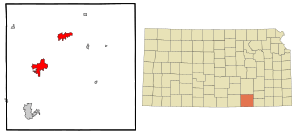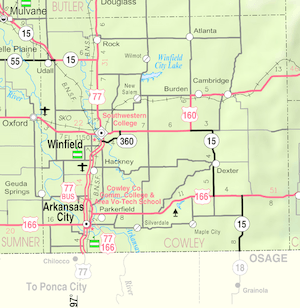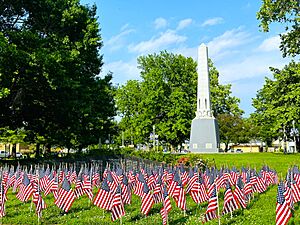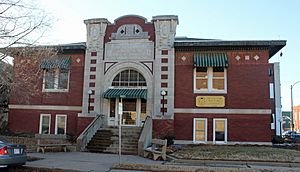Winfield, Kansas facts for kids
Quick facts for kids
Winfield, Kansas
|
|
|---|---|
|
City and county seat
|
|

Downtown Winfield in June 2023
|
|

Location within Cowley County and Kansas
|
|

|
|
| Country | United States |
| State | Kansas |
| County | Cowley |
| Township | Walnut, Vernon, P.V. |
| Founded | 1870 |
| Incorporated | 1873 |
| Named for | Winfield Scott |
| Area | |
| • Total | 12.51 sq mi (32.41 km2) |
| • Land | 11.14 sq mi (28.86 km2) |
| • Water | 1.37 sq mi (3.55 km2) 10.60% |
| Elevation | 1,139 ft (347 m) |
| Population
(2020)
|
|
| • Total | 11,777 |
| • Density | 941.4/sq mi (363.38/km2) |
| Time zone | UTC-6 (CST) |
| • Summer (DST) | UTC-5 (CDT) |
| ZIP code |
67156
|
| Area code | 620 |
| FIPS code | 20-79950 |
| GNIS ID | 485663 |
Winfield is a city in Kansas, located in Cowley County. It is the main city, also known as the county seat, of Cowley County. Winfield is found along the Walnut River in the south-central part of Kansas.
As of the 2020 census, about 11,777 people live in Winfield. The city is also home to Southwestern College.
Contents
History of Winfield, Kansas
Winfield's Beginnings in the 1800s
Winfield was started in 1870. It was named after Reverend Winfield Scott. He promised to build a church in the town if they named it after him. The first post office opened in Winfield in May 1870. By 1873, Winfield officially became a city.
Railroads Arrive in Winfield
In 1877, a railroad company built a line that reached Winfield by October 1, 1879. This line connected Winfield to other towns like Florence and Arkansas City. The Atchison, Topeka and Santa Fe Railway operated this line.
Another railroad, the Southern Kansas and Western Railroad, arrived in Winfield in 1880. Over time, this railroad changed its name as it joined with other companies. Eventually, five different railroads passed through Winfield, helping the town grow.
Winfield in the 1900s
Winfield is home to Southwestern College, a private college linked to the United Methodist Church. Another college, St. John's College, was also in Winfield but closed in 1986.
The city is famous for hosting the Walnut Valley Festival. This is a big music festival that celebrates bluegrass and acoustic music. It happens every September.
From 1952 to 1997, a Crayola factory that made crayons was located in Winfield.
Winfield in the 2000s
In 2010, the Keystone-Cushing Pipeline was built west of Winfield. There were some discussions about taxes and environmental worries related to the pipeline.
In 2011, Newell Rubbermaid decided to expand its business in Winfield. They moved 200 jobs from Texas to Winfield. Rubbermaid also invested $26.6 million to grow its operations, including building a large new distribution center.
Geography and Climate of Winfield
Where is Winfield Located?
Winfield is located along the Walnut River. It is about 17 miles (27 km) north of the border between Kansas and Oklahoma. The city is at the meeting point of U.S. Routes 77 and 160.
Winfield covers a total area of about 12.93 square miles (33.49 square kilometers). Most of this area, 11.56 square miles (29.94 square kilometers), is land. The rest, 1.37 square miles (3.55 square kilometers), is water.
Winfield's Weather and Temperatures
Winfield has a range of temperatures throughout the year. In January, the average low temperature is below 20°F (-7°C). In July, the average high temperature is nearly 93°F (34°C).
Temperatures reach 90°F (32°C) about 69 days a year. They can even reach 100°F (38°C) about 12 days a year. The temperature drops below freezing (32°F or 0°C) about 102 days a year.
Rainfall and Snow in Winfield
Winfield gets about 38 inches (965 mm) of rain each year. Most of the rain falls in May and June. It snows about 12 inches (30 cm) on average during the winter. However, often less than 3 inches (7.6 cm) of snow falls. Measurable snow falls about 7 days a year.
Population and People of Winfield
| Historical population | |||
|---|---|---|---|
| Census | Pop. | %± | |
| 1870 | 472 | — | |
| 1880 | 2,844 | 502.5% | |
| 1890 | 5,184 | 82.3% | |
| 1900 | 5,554 | 7.1% | |
| 1910 | 6,700 | 20.6% | |
| 1920 | 7,933 | 18.4% | |
| 1930 | 9,398 | 18.5% | |
| 1940 | 9,506 | 1.1% | |
| 1950 | 10,264 | 8.0% | |
| 1960 | 11,117 | 8.3% | |
| 1970 | 11,405 | 2.6% | |
| 1980 | 10,736 | −5.9% | |
| 1990 | 11,931 | 11.1% | |
| 2000 | 12,206 | 2.3% | |
| 2010 | 12,301 | 0.8% | |
| 2020 | 11,777 | −4.3% | |
| U.S. Decennial Census 2010-2020 |
|||
Winfield's Population in 2020
The 2020 United States census counted 11,777 people living in Winfield. There were 4,339 households and 2,687 families. The population density was about 1,057 people per square mile (408 per square kilometer).
Most of the people living in Winfield, about 80%, were white. About 4% were black or African-American, and about 3.5% were Asian. People of Hispanic or Latino background made up about 9% of the population.
About 23.7% of the population was under 18 years old. The average age in the city was 35 years.
Winfield's Population in 2010
In the census of 2010, there were 12,301 people in Winfield. There were 4,600 households. The population density was about 1,064 people per square mile (411 per square kilometer).
The racial makeup was similar to 2020, with about 85.7% White residents. About 3.9% were African American, and 3.9% were Asian. Hispanic or Latino people made up 6.1% of the population.
About 23% of residents were under 18 years old. The median age was 36.7 years.
Economy and Jobs in Winfield
Early Industries in Winfield
In the 1800s, railroads were very important for Winfield's economy. They helped transport goods and people. As mentioned earlier, five different railroads eventually passed through the city.
In 1888, a large state hospital was built in Winfield. It was called the Kansas State Imbecile Asylum, and later the Winfield State Hospital and Training Center. For over 100 years, this hospital was a major employer in the area. It provided care for people with mental health needs from all over Kansas.
Winfield's Industries in the 1900s
The Winfield area has many different types of industrial jobs. Many of these jobs are found at Strother Field, which is an airport shared by Winfield and Arkansas City.
Making Consumer Goods
In 1916, Gott Manufacturing started in Winfield. They made metal water coolers. Later, in 1986, a company called Rubbermaid bought Gott. Rubbermaid is known for making storage containers. The Winfield factory then started making Rubbermaid products like insulated water coolers and outdoor storage items.
A Crayola factory also made crayons in Winfield from 1952 to 1997.
Aviation Industry in Winfield
Strother Field Airport
During World War II in 1942, Winfield and Arkansas City started building a shared airport. The military took over the project and finished it, naming it Strother Field. It was used to train military pilots during the war.
In 1953, the airport went back to being controlled by Winfield and Arkansas City. It became a big center for industries in both communities.
GE Aviation in Winfield
In 1951, GE Aviation, a part of General Electric that makes aircraft engines, started working at Strother Field. They made General Electric J47 jet engines for military planes like the Boeing B-47 Stratojet. By 1955, they had made about 3,000 of these engines.
After the Korean War, the GE factory began fixing and repairing jet engine parts. From 1962 to 1975, they repaired over 6,000 military jet engines. Later, they also serviced engines for business jets. Many business jets from around the world would fly to Strother Field for service at the GE factory.
Cessna Aircraft Company
In 1967, Cessna Aircraft Company opened a factory at Strother Field. Cessna was famous for making many light aircraft. The factory first made the Cessna 150, a popular two-seat plane used for pilot training.
In 1975, Cessna also started assembling the Cessna 172, another very popular light aircraft, at Strother Field. Thousands of these planes were made there. The factory employed many workers. However, in the 1980s, the demand for light aircraft dropped, and Cessna eventually closed its factory at Strother Field.
Changes at the State Hospital
The Winfield State Hospital and Training Center continued to be a major employer in the 20th century. At its busiest in 1952, it housed up to 1,492 people.
Towards the end of the century, the hospital changed. It began to focus on helping people with developmental disabilities. Due to new ideas and laws, it became more common to support these individuals in their communities. This was also less expensive for the state. In 1998, the Kansas Legislature voted to close the hospital. At that time, it was the oldest and largest state hospital for people with developmental disabilities in Kansas. When it closed, about 250 residents were still living there.
The hospital building was then taken over by the Kansas Department of Corrections. It was turned into the Winfield Correctional Facility, which can hold up to 556 prisoners.
Winfield's Economy in the 2000s
Many of Winfield's main employers continued into the 21st century. Strother Field airport is still a big industrial park, providing thousands of jobs.
In 2011–2012, Newell Rubbermaid expanded its operations in Winfield. They added manufacturing for trash cans and home-organization products. They also built a large distribution center. By early 2017, the company employed 1,054 people.
GE Aviation, which started in Winfield in 1947, continues to operate. In April 2017, it employed 750 people in the area.
Other important employers in the area include Creekstone Farms, a beef processing plant in nearby Arkansas City, and hospitals and nursing homes. William Newton Memorial Hospital in Winfield is one of these. The Winfield Correctional Facility also employs about 200 people.
Arts and Culture in Winfield
Walnut Valley Festival
Winfield is very famous for hosting the Walnut Valley Festival. This is one of the oldest and largest bluegrass and acoustic music festivals in the country. It takes place every September on the third weekend.
More than 15,000 people come to the festival from all over the nation. Many of these music fans camp and play music together for weeks before the festival officially starts. The event also often includes folk music and Celtic music performances, along with other cultural activities.
Education in Winfield
Schools for Kids in Winfield
The public schools in Winfield are part of the Winfield USD 465 school district. This district operates Winfield High School.
Colleges in Winfield
Southwestern College is located in Winfield. It is a four-year private college that is connected to the United Methodist Church.
St. John's College was also in Winfield but closed in 1986.
Media in Winfield
Local Newspapers
- The Cowley Courier Traveler is the local newspaper for both Winfield and Arkansas City. It was formed when The Winfield Daily Courier and The Arkansas City Traveler merged.
Radio Stations
Winfield has several radio stations:
- KKLE, 1550 AM, plays News/Talk shows.
- KBDD, 91.9 FM, plays Religious programs.
- KSWC, 94.7 FM, is a college radio station (low power).
- KSOK, 95.9 FM, plays Country music.
- KSOK, 103.3 FM, plays Classic Hits (this is a translator for KSOK-AM).
- KSOK-AM, 1280 AM, plays Classic Hits.
- KWLS, 107.9 FM, plays Country music.
Notable People from Winfield
Many interesting people have come from Winfield, Kansas:
- Robert A. Alberty, a scientist who studied biophysical chemistry.
- Bob Brannum, a basketball player.
- Gilbert Bundy (1911–1955), a cartoonist and illustrator.
- Darren E. Burrows, an artist, director, and actor, known for playing Ed Chigliak in the TV show Northern Exposure.
- Josh Clarke, a baseball player.
- Harold Corbin, an Olympian in fencing.
- Ira Davenport, an Olympic bronze medal winner in track and field.
- Greta Goodwin, who served in the Kansas Senate and Kansas House of Representatives.
- John Harts, a football coach.
- Bob Kenney, a basketball player who won an NCAA National Men's Basketball Championship with the University of Kansas in 1952 and an Olympic gold medal in 1952.
- Richard Mawdsley, an artist known for his work with metals.
- Ruth Maycliffe (1888-1981), a Broadway actress.
- George McDermott, a U.S. federal judge.
- Eugene Pallette, an actor who appeared in over 240 movies.
- Steve Sidwell, a football coach.
- Dean Strother, a four-star general in the U.S. Air Force.
- Caroline Thorington, an artist.
- Karen Wheeler, an artist.
Images for kids
See also
 In Spanish: Winfield (Kansas) para niños
In Spanish: Winfield (Kansas) para niños



